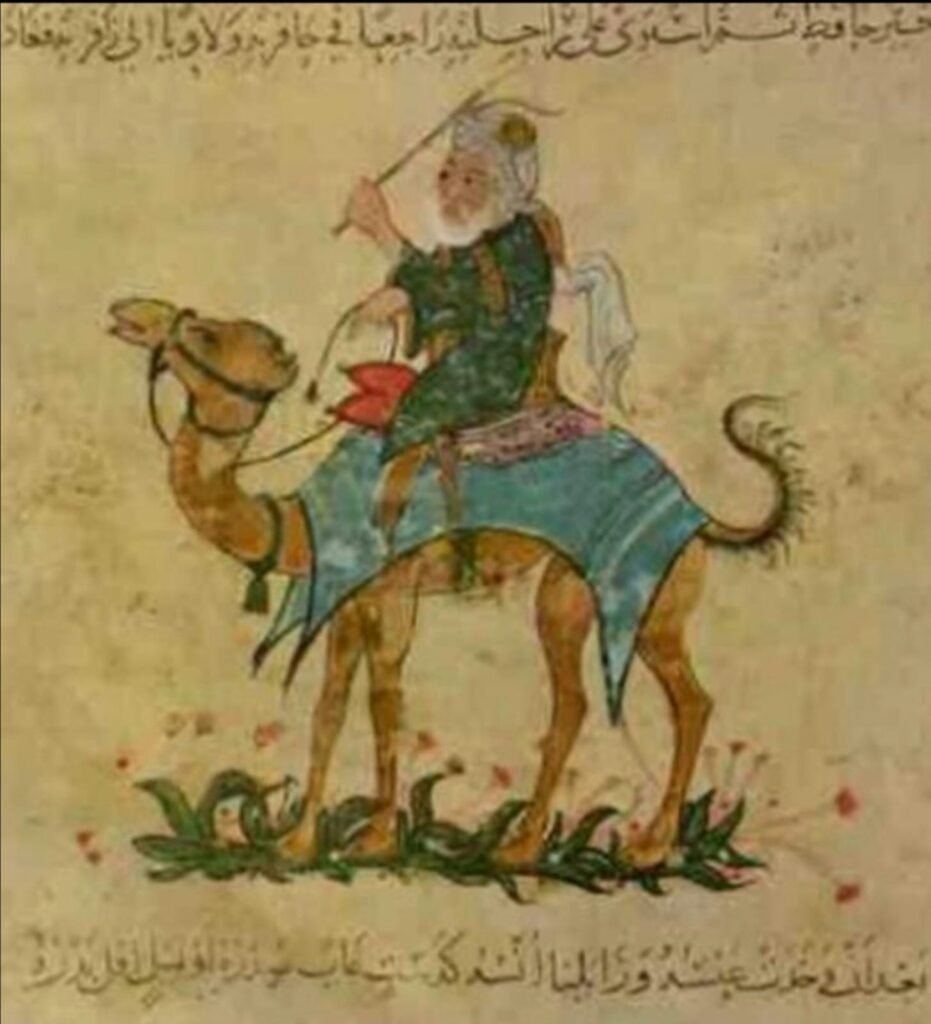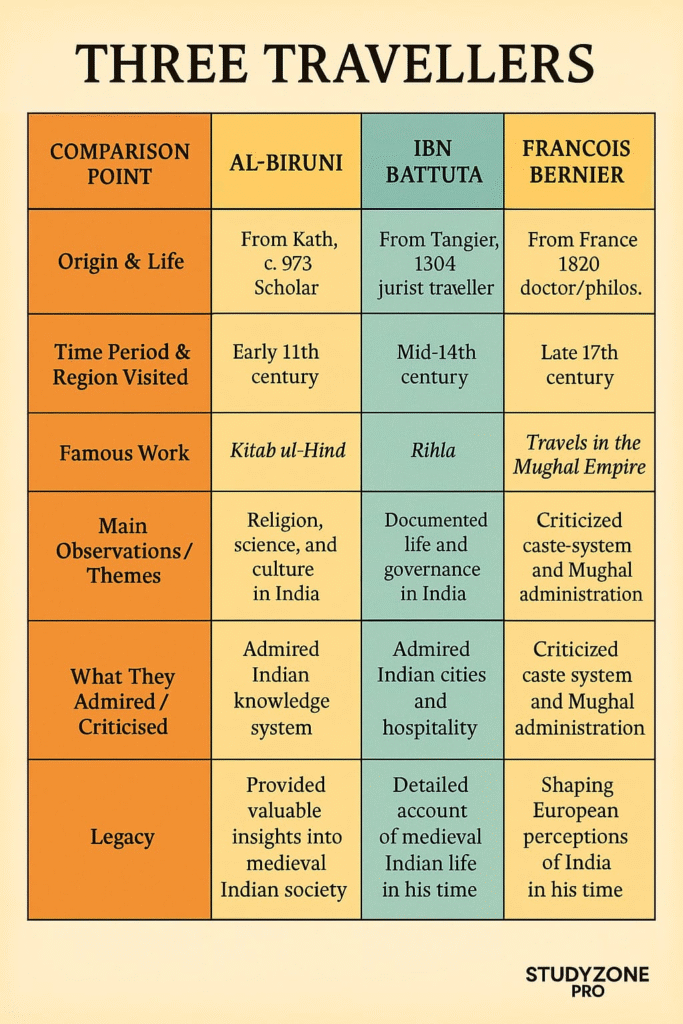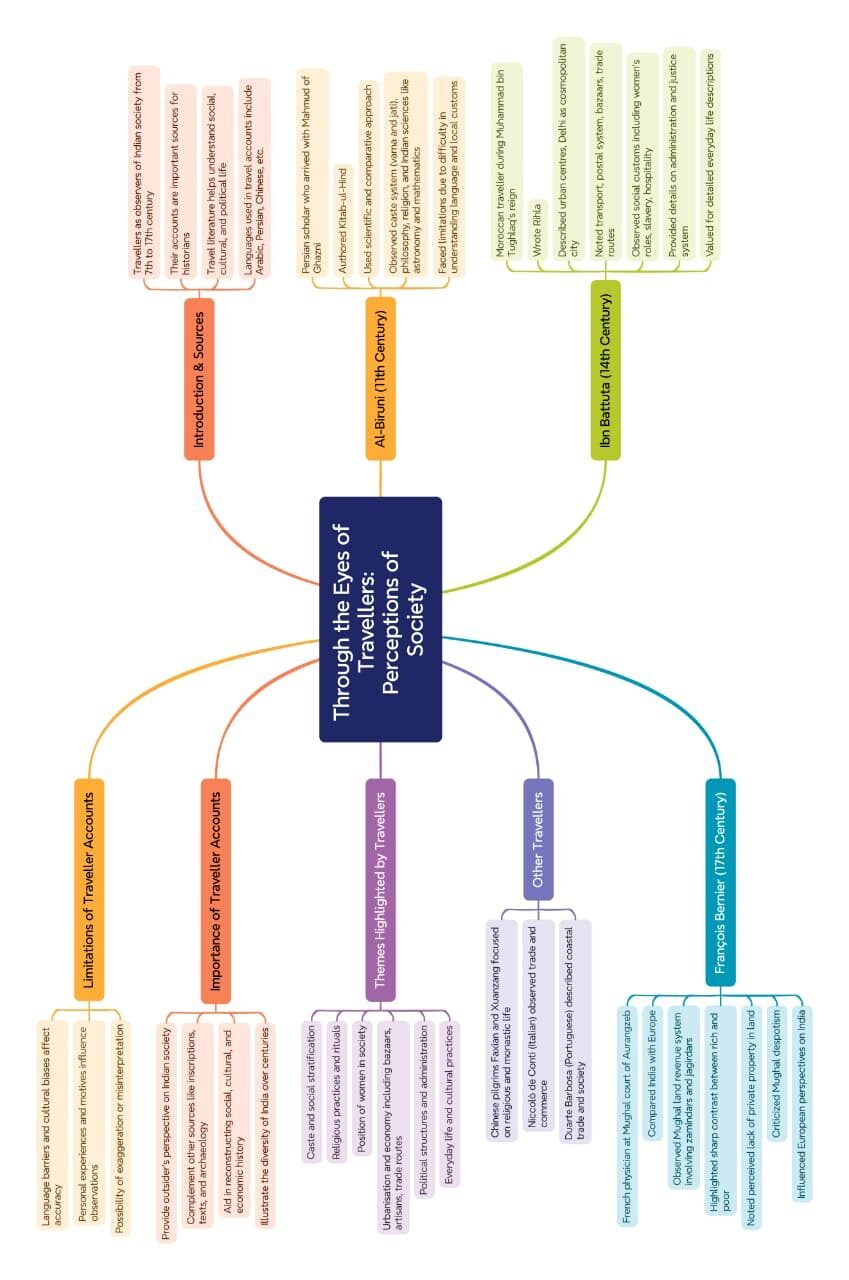Class 12 : History (English) – Lesson 5 Through the Eyes of Travellers
EXPLANATION & SUMMARY

Ibn Battuta
This chapter explores Indian society, economy, culture, and polity through the accounts of foreign travellers who visited the subcontinent between the 7th and 17th centuries. These travellers came from China, the Arab world, Central Asia, and Europe. Their writings provide a unique external perspective, revealing how India appeared to outsiders and how diverse aspects of Indian civilization were recorded, understood, or even misunderstood.
Importance of Travel Accounts
Travellers came to India for many reasons: some for religious pilgrimages, some for trade, and others as part of diplomatic missions or personal curiosity. Their observations, though subjective, are valuable historical sources. They offer insights into the socio-cultural, political, and economic aspects of Indian life. While these accounts were often coloured by the travellers’ own cultures, biases, and purposes, they provide rare information not found in indigenous sources.
Al-Biruni – A Scholar from the Islamic World
One of the earliest and most important visitors was Al-Biruni, who came to India in the 11th century along with Mahmud of Ghazni. A Persian scholar deeply interested in Indian knowledge systems, Al-Biruni wrote a detailed account of Indian society in his work Kitab-ul-Hind.
Al-Biruni admired the intellectual achievements of Indians in fields like astronomy, mathematics, and philosophy. However, he found it difficult to understand Indian social customs, especially caste and ritual purity. He believed language and religion acted as barriers to interaction between Hindus and Muslims. He attempted to study Sanskrit texts and compared Indian knowledge systems with Greek and Islamic traditions.
Ibn Battuta – The Curious Traveller from Morocco
Ibn Battuta, a 14th-century Moroccan traveller, visited India during the reign of Muhammad bin Tughlaq. His account Rihla is full of detailed descriptions of cities, governance, courtly life, and everyday experiences.
He observed the opulence of Indian cities like Delhi and the splendour of the Sultan’s court. He noted the Sultan’s unpredictable behaviour and harsh punishments but also appreciated the cultural diversity and hospitality of Indian people. Ibn Battuta was impressed by the variety of goods in Indian markets and described the bustling trade and urban economy.
His travelogue reflects the social contradictions of the time—prosperity alongside fear, and strict governance alongside cultural vibrancy.
François Bernier – A European View of Mughal India
François Bernier, a French physician and philosopher, came to India in the 17th century and lived at the Mughal court for over a decade. His writings are highly analytical and often compare Indian society with Europe.
Bernier criticized the Mughal system of revenue collection, particularly the zamindari and jagirdari systems, which he believed discouraged private property and agricultural improvement. He argued that Indian peasants were impoverished due to oppressive taxation and lack of incentives.
He also described India as a place of great riches but plagued by despotism and social inequality. Bernier’s accounts were influential in shaping European ideas of the “Orient” and contributed to the notion of Asia being stagnant and despotic compared to dynamic Europe.
Themes in Travel Accounts
Several common themes emerge from the accounts of these and other travellers:
Caste and Social Stratification: Most travellers noted the rigid caste system and practices like untouchability. While some described these customs neutrally, others were shocked or critical.
Religious Diversity: Travellers were amazed by the coexistence of multiple religions—Hinduism, Islam, Jainism, Buddhism, Christianity, and others. Many described festivals, pilgrimages, and religious debates.
Urban Life and Markets: Accounts of cities like Delhi, Surat, and Varanasi show that India had vibrant urban centres, busy markets, and thriving crafts and trade. Goods like spices, textiles, and gems attracted traders from all over the world.
Court Life and Polity: Many travellers spent time in royal courts and observed the grandeur, rituals, and bureaucracy of Indian kings, particularly the Delhi Sultans and Mughal emperors. Some, like Bernier, compared it unfavourably with European political systems.
Gender and Women: Travellers offered varying views on the condition of women. While some noted the seclusion of women (purdah), others saw educated and powerful women in royal households.
Limitations and Value of Travel Accounts
Travel accounts are subjective, shaped by the traveller’s background, purpose, and cultural perspective. Language barriers and reliance on local informants sometimes led to misinterpretations or exaggerations. Yet, these narratives offer precious external views on Indian society.
They complement indigenous records and fill in gaps left by official histories. For example, while court chronicles may glorify rulers, travellers often mention the sufferings of common people, social tensions, or regional differences.
Conclusion
The writings of Al-Biruni, Ibn Battuta, François Bernier, and others are vital sources for reconstructing Indian history. They offer not only factual information but also reflections of how India was perceived by the wider world. Their observations highlight India’s wealth, diversity, contradictions, and complexity. Though coloured by cultural biases, these accounts reveal a dynamic society constantly evolving through internal processes and global interactions. Studying India “through the eyes of travellers” deepens our understanding of the subcontinent’s past and its place in global history.

————————————————————————————————————————————————————————————————————————————
QUESTIONS FROM TEXTBOOK
🔷 Q1. Write a note on the Kitab-ul-Hind.
🔖 Answer:
🔹 Kitab-ul-Hind was written by Al-Biruni, a Persian scholar who visited India in the 11th century.
🔹 It was originally written in Arabic and gives detailed descriptions of Indian religion, philosophy, customs, caste system, astronomy, mathematics, and social life.
🔹 Al-Biruni used a comparative approach, studying Sanskrit texts and trying to understand Indian traditions from within.
🔹 Despite cultural and linguistic barriers, his work reflects deep intellectual curiosity and respect.
✅ Kitab-ul-Hind remains a landmark source for reconstructing Indian society during the early medieval period.
🔷 Q2. Compare and contrast the perspectives from which Ibn Battuta and Bernier wrote their accounts of their travels in India.
🔖 Answer:
🔹 Ibn Battuta was a 14th-century Moroccan traveller who observed India during Muhammad bin Tughlaq’s rule. His narrative was experiential, engaging, and mostly positive, emphasizing travel, culture, and diversity.
🔹 In contrast, François Bernier, a 17th-century Frenchman, arrived during Aurangzeb’s reign. His account was analytical, judgmental, and compared India negatively with Europe.
🔹 While Battuta appreciated markets, cities, and people, Bernier criticized poverty, despotism, and the absence of private property.
✅ Their writings offer contrasting lenses: Battuta’s was immersive; Bernier’s was critical and Eurocentric.
🔷 Q3. Discuss the picture of urban centres that emerges from Bernier’s account.
🔖 Answer:
🔹 Bernier described Indian cities as disorganized, crowded, and lacking sanitation.
🔹 He blamed the Mughal emperors’ centralized power and absence of private property for urban decline.
🔹 Roads were unpaved, houses unplanned, and public services minimal.
🔹 However, he admired the skilled craftsmanship of artisans in cities like Agra, Delhi, and Lahore.
✅ His account reflects urban inequality—a rich ruling elite amidst general poverty and poor infrastructure.
🔷 Q4. Analyse the evidence for slavery provided by Ibn Battuta.
🔖 Answer:
🔹 Ibn Battuta noted that slavery was widespread in India during the 14th century.
🔹 Both men and women slaves were employed as attendants, guards, dancers, and cooks.
🔹 Slaves were gifted by nobles and rulers; many came from wars, others were purchased.
🔹 Some had comfortable lives, receiving gifts and rewards.
✅ His account helps us understand the social acceptance, uses, and variety of slavery in medieval India.
🔷 Q5. What were the elements of the practice of sati that drew the attention of Bernier?
🔖 Answer:
🔹 Bernier was disturbed by the practice of sati, where widows were burnt on their husband’s pyres.
🔹 He described the public nature of the ritual, complete with music, chanting, and large crowds.
🔹 He suspected coercion, despite claims of voluntary sacrifice.
🔹 He viewed sati as a symbol of religious extremism and gender inequality.
✅ His writing offers a European critique of Indian customs and highlights women’s oppression under ritual practices.
🟨 Short Essay Questions (250–300 words each)
🔶 Q6. Discuss Al-Biruni’s understanding of the caste system.
🔖 Answer:
🔹 Al-Biruni described the caste system as rigid and hierarchical.
🔹 He identified the four varnas (Brahmins, Kshatriyas, Vaishyas, Shudras) and the emergence of hundreds of jatis.
🔹 He noted that caste was determined by birth, not merit, and controlled interaction, marriage, and food-sharing.
🔹 He compared Indian society with Islamic egalitarianism, where mobility was allowed.
🔹 Though he acknowledged the scholarly and religious basis of caste, he criticized it for social division and inequality.
🔹 He studied Sanskrit texts like Manusmriti to understand its origins.
✅ Al-Biruni’s account is significant because it reveals how caste functioned in practice, not just in theory. He remains one of the earliest foreign analysts of India’s caste system.
🔶 Q7. Do you think Ibn Battuta’s account is useful in arriving at an understanding of life in contemporary urban centres? Give reasons for your answer.
🔖 Answer:
🔹 Yes, Ibn Battuta’s account is a valuable source for understanding urban life in 14th-century India.
🔹 He visited Delhi, Malabar, Daulatabad, and described bustling markets, courtly life, mosques, and roads.
🔹 He wrote about crowded bazaars, organized policing, and urban hospitality.
🔹 His observations on food, rituals, architecture, and punishments provide a ground-level view.
🔹 He noted social diversity and highlighted the presence of women in public life, like in the markets of Malabar.
🔹 However, his Islamic lens sometimes led to bias, especially in describing non-Islamic practices.
✅ Still, his firsthand experiences help historians reconstruct daily life, urban culture, and administrative details with depth and color.
🔶 Q8. Discuss the extent to which Bernier’s account enables historians to reconstruct contemporary rural society.
🔖 Answer:
🔹 Bernier, though mostly city-based, did travel through rural areas, and his account gives glimpses into village life under Mughal rule.
🔹 He noted the absence of private property, with land under state control (jagirdari system).
🔹 He believed this discouraged agricultural innovation, making peasants poor and villages stagnant.
🔹 Bernier described the zamindars’ oppression, crop sharing, and forced labor.
🔹 However, his analysis was based on European property ideals, and he misunderstood some Indian systems.
🔹 His bias toward European capitalism led him to portray India’s rural economy as backward.
✅ Despite limitations, his writings help understand the structure of land ownership, peasant condition, and rural inequality.
🔶 Q9. Read this excerpt from Bernier… List the crafts mentioned in the passage. Compare these with the descriptions of artisanal activity in the chapter.
🔖 Answer:
🔹 Crafts mentioned by Bernier:
💠 Musket-making
💠 Fowling-piece making
💠 Gold ornament crafting
💠 Painting (noted for beauty and delicacy)
🔹 He admired the high-quality workmanship, especially by poor artisans using minimal tools.
🔹 He compared Indian artisans’ copies of European goods, noting they were almost indistinguishable from the originals.
🔹 However, he also saw Indian artisans as lacking freedom, working under rich patrons.
🔹 The chapter confirms that Indian artisans were highly skilled, with guilds and specialisation.
🔹 Textile production, metalwork, and jewellery were especially advanced in centres like Surat, Banaras, and Lahore.
✅ Thus, Bernier’s account reinforces the view that Indian artisanal tradition was rich and refined, though limited by social and economic structures.
————————————————————————————————————————————————————————————————————————————
OTHER IMPORTANT QUESTIONS FOR EXAMS
(CBSE MODEL QUESTIONS PAPER)
ESPECIALLY MADE FROM THIS LESSON ONLY
Question 1: Who authored Kitab-ul-Hind?
a) Ibn Battuta
b) Al-Biruni
c) Marco Polo
d) Bernier
Answer: b) Al-Biruni
Question 2: Ibn Battuta came to India during the reign of:
a) Alauddin Khalji
b) Firoz Shah Tughlaq
c) Muhammad bin Tughlaq
d) Iltutmish
Answer: c) Muhammad bin Tughlaq
Question 3: François Bernier was associated with the court of which Mughal ruler?
a) Humayun
b) Akbar
c) Shah Jahan
d) Aurangzeb
Answer: c) Shah Jahan
Question 4: Al-Biruni was originally from:
a) Turkey
b) Persia
c) Arabia
d) Spain
Answer: b) Persia
Question 5: Which of the following travellers was Moroccan?
a) Bernier
b) Al-Biruni
c) Ibn Battuta
d) Fa-Hien
Answer: c) Ibn Battuta
Question 6: Which traveller wrote Rihla?
a) Al-Biruni
b) Marco Polo
c) Ibn Battuta
d) Megasthenes
Answer: c) Ibn Battuta
Question 7: Bernier believed that India lacked:
a) Religious tolerance
b) Agricultural diversity
c) Private property rights
d) Market economy
Answer: c) Private property rights
Question 8: Al-Biruni found the caste system:
a) Logical and scientific
b) Easily understandable
c) Complex and alien
d) Similar to Islamic society
Answer: c) Complex and alien
Question 9: What kind of source is a traveller’s account?
a) Literary fiction
b) Official document
c) Primary source
d) Religious text
Answer: c) Primary source
Question 10: Which city did Ibn Battuta describe as full of markets and cultural activity?
a) Agra
b) Banaras
c) Delhi
d) Multan
Answer: c) Delhi
II. Fill in the Blanks (3 Questions)
Question 11: The book written by Al-Biruni on Indian society is called __.
Answer: Kitab-ul-Hind
Question 12: Ibn Battuta wrote his travel account in a book titled __.
Answer: Rihla
Question 13: Bernier criticized the Mughal system for lacking the concept of __.
Answer: Private property
III. Right or Wrong (2 Questions)
Question 14: Al-Biruni learned Sanskrit to understand Indian philosophy.
Answer: Right
Question 15: Ibn Battuta praised Muhammad bin Tughlaq’s consistent and gentle nature.
Answer: Wrong
IV. Assertion–Reason Questions (3 Questions)
Question 16:
Assertion (A): Ibn Battuta observed both the splendour and unpredictability of Sultanate rule.
Reason (R): He served as a court historian under Iltutmish.
a) Both A and R are true, and R is the correct explanation of A.
b) Both A and R are true, but R is not the correct explanation of A.
c) A is true, R is false.
d) A is false, R is true.
Answer: c) A is true, R is false.
Question 17:
Assertion (A): Bernier believed India’s economy suffered due to the absence of private land ownership.
Reason (R): He saw Europe’s feudal system as more progressive.
Answer: a) Both A and R are true, and R is the correct explanation of A.
Question 18:
Assertion (A): Al-Biruni admired Indian intellectual traditions.
Reason (R): He rejected all Indian religious practices and knowledge systems.
Answer: c) A is true, R is false.
V. One-word or Two-word Answers (7 Questions)
Question 19: Name the book written by Bernier.
Answer: Travels in the Mughal Empire
Question 20: Where was Ibn Battuta originally from?
Answer: Morocco
Question 21: What language did Al-Biruni learn to study Indian texts?
Answer: Sanskrit
Question 22: What was the religion of Al-Biruni?
Answer: Islam
Question 23: Which Indian ruler did Bernier serve under?
Answer: Shah Jahan
Question 24: What system of governance did Bernier criticize?
Answer: Mughal jagirdari system
Question 25: Which term refers to the group that included both monks and nuns in Buddhist tradition?
Answer: Sangha
VI. Case Study-Based Questions (5 Questions)
Case Study Passage:
François Bernier, a French physician and philosopher, lived in India during Shah Jahan’s reign. He observed Mughal administration and economic structures critically. In his writings, Bernier compared India with Europe, stating that India lacked private land ownership, which he believed led to the poverty of peasants. He also described the rich diversity of Indian society and highlighted the wealth and splendour of the Mughal court, while criticising the political despotism.
Question 26 (MCQ): According to Bernier, what was the main reason for India’s economic weakness?
a) Lack of irrigation
b) Weak kingship
c) Absence of private property
d) Religious diversity
Answer: c) Absence of private property
Question 27 (MCQ): Under whose reign did Bernier visit India?
a) Akbar
b) Aurangzeb
c) Shah Jahan
d) Jahangir
Answer: c) Shah Jahan
Question 28: How did Bernier compare India with Europe in terms of governance?
Answer: He saw Indian rule as despotic and stagnant, whereas Europe encouraged freedom and private ownership.
Question 29: What contradiction did Bernier observe in Mughal India?
Answer: He noted great royal wealth but widespread poverty and oppression of peasants.
Question 30: Why are Bernier’s observations historically significant despite their bias?
Answer: They offer a critical European perspective and help understand how India was viewed externally.
————————————————————————————————————————————————————————————————————————————
QUESTIONS FROM COMPETITION EXAMS
🔵 Q1. Who was the author of Rihla, an account of travels in the 14th century?
(A) Al-Beruni
(B) Ibn Battuta
(C) Marco Polo
(D) Francois Bernier
✅ Answer: (B) Ibn Battuta
📅 Exam: UPSC Prelims 2017
📝 Explanation: Rihla was written by Ibn Battuta, a Moroccan traveler who visited India during the reign of Muhammad-bin-Tughlaq.
🟢 Q2. Who among the following visited India during the reign of Muhammad-bin-Tughlaq?
(A) Al-Beruni
(B) Ibn Battuta
(C) Marco Polo
(D) Megasthenes
✅ Answer: (B) Ibn Battuta
📅 Exam: SSC CGL 2016
📝 Explanation: Ibn Battuta was appointed Qazi by Muhammad-bin-Tughlaq and recorded his experiences in Rihla.
🔴 Q3. Who among the following was a French traveler who visited India during the reign of Aurangzeb?
(A) Francois Bernier
(B) Niccolao Manucci
(C) Tavernier
(D) Ibn Battuta
✅ Answer: (A) Francois Bernier
📅 Exam: UPPCS 2018
📝 Explanation: Francois Bernier’s accounts provide insights into Mughal India’s society and economy.
🟡 Q4. Who among the following is correctly matched with his book?
(A) Francois Bernier – Travels in Mughal India
(B) Ibn Battuta – Rihla
(C) Al-Beruni – Kitab-ul-Hind
(D) All of the above
✅ Answer: (D) All of the above
📅 Exam: SSC CHSL 2019
📝 Explanation: All three travelers wrote famous accounts of India, widely used for historical analysis of medieval Indian society.
————————————————————————————————————————————————————————————————————————————
MNEMONICS

————————————————————————————————————————————————————————————————————————————
MIND MAPS

